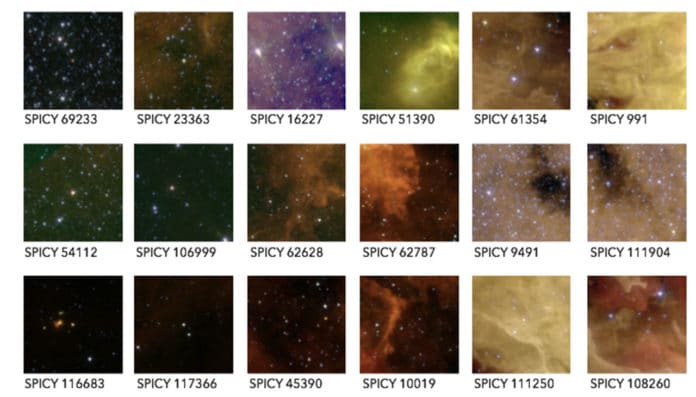Using observational data from the Infrared Array Camera of NASA’s Spitzer Space Telescope, an international team of Astronomers from the Cosmostatistics Initiative (COIN) identified nearly 120,000 new young stellar objects (YSOs). This catalog, named SPICY (Spitzer/IRAC Candidate YSO Catalog), is publicly available to anyone who wishes to study the first stages of stellar development.
The Spitzer Space Telescope devoted significant time to scanning large areas of our Galaxy in a hunt for YSOs. Our Galaxy is shaped like a disk, with both our Sun and star-forming regions located inside the disk, meaning that most star-forming regions can be found in a thin strip that circles the sky.
During an observing campaign named GLIMPSE, Spitzer took high-resolution images of this strip revealing tens of millions of stars. However, this posed another very difficult question: how to find young stars among the tens of millions of objects present in such a large data set?
To solve this puzzle, members of the Cosmostatistics Initiative employed a classification scheme that uses the flexibility of cutting edge machine learning and curated YSO datasets to take full advantage of IRAC’s spatial resolution and sensitivity in the mid-infrared ∼3–9 μm range.
Multi-wavelength color/magnitude distributions provide intuition about how the classifier separates YSOs from other red IRAC sources and validate that the sample is consistent with expectations for disk/envelope-bearing pre-main-sequence stars.
Multi-wavelength color/magnitude distributions give instinct about how the classifier separates YSOs from other red IRAC sources and approve that the sample is predictable with desires for disk/envelope-bearing pre-main-sequence stars.

Located in the Galactic midplane’s inner region, most of the candidates are in regions with mid-IR nebulosity, associated with star-forming clouds, but others appear distributed in the field. Using distance estimates from the ESA Gaia satellite, scientists found groups of YSO candidates related to the Local Arm, the Sagittarius-Carina Arm, and the Scutum-Centaurus Arm. Candidate YSOs visible to the Zwicky Transient Facility tend to exhibit higher variability amplitudes than randomly selected field stars of the same magnitude, with many high-amplitude variables having light-curve morphologies characteristic of YSOs.
According to the team, given that no current or planned instruments will significantly exceed IRAC’s spatial resolution while possessing its wide-area mapping capabilities, Spitzer-based catalogs such as this one will remain the main resources mid-infrared YSOs in the Galactic midplane for the near future.
Journal Reference:
- SPICY: The Spitzer/IRAC Candidate YSO Catalog for the Inner Galactic Midplane, arXiv:2011.12961 [astro-ph.GA] arxiv.org/abs/2011.12961
